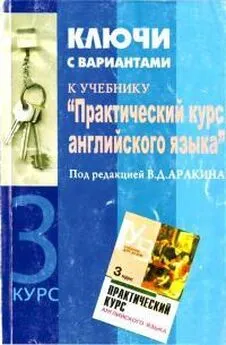Яков Аракин - Практический курс английского языка 2 курс
- Название:Практический курс английского языка 2 курс
- Автор:
- Жанр:
- Издательство:ВЛАДОС
- Год:2005
- ISBN:нет данных
- Рейтинг:
- Избранное:Добавить в избранное
-
Отзывы:
-
Ваша оценка:
Яков Аракин - Практический курс английского языка 2 курс краткое содержание
I - V курсов педагогических вузов.
Цель учебника – обучение устной речи на основе развития необходимых автоматизированных речевых навыков, развитие техники чтения, а также навыков письменной речи.
Практический курс английского языка 2 курс - читать онлайн бесплатно полную версию (весь текст целиком)
Интервал:
Закладка:
Where is he, then?
I am leaving.
Oh, can't you stay a bit longer?
She is crying.
Oh, hasn't she passed her exam?
The picture's wonderful.
Let me have a look at it.
Mother is asleep.
Don't disturb her, Tom.
Look at his clothes.
Good Heavens!
Good afternoon, Mrs. White.
Hallo, Betty dear!
II. HIGH PRE-HEAD + HIGH FALL (+TAIL)
Model: -I'd simply \love to.
7. Listen carefully to the following conversational situations. Concentrate your attention on
the intonation of the replies:
Verbal Context
Drill
Did he say anything?
No, nothing, you'll be pleased to hear.
We're going ahead without Paul.
That's obviously the best solution.
Have some more pudding, Ann.
I couldn't possibly.
You'll help, won't you, Max.
Why me?
I was against the proposal.
What did Jack have to say about it?
You can borrow mine.
D'you mean that?
He says he'll do better in future.
Does he really intend to work harder?
Shall I ask him to tea?
By all means ask him.
I'm going to play tennis.
Let's all have a game.
No luck, I'm afraid.
Try once more, then.
I'm not sure I want to go.
Stay at home, then.
He's broken a leg.
How awful!
Looking for me, Terry?
Oh, there you are, Peter.
8. Listen to the replies, and repeat them in the intervals. Make your voice rise
high when pronouncing the High Pre-Head.
9. Listen to the Verbal Context and reply in the intervals.
10. In order to fix the High Pre-Head in your mind, ear and speech habits
pronounce each reply several times until it sounds perfectly natural to you.
11. Listen to a fellow-student reading the replies. Tell him (her) what his (her)
errors in pronunciation are.
12. Read the drill sentences according to the given model. Concentrate your attention on the
High Pre-Head:
Verbal Context
Drill
Was it difficult?
Surprisingly so.
I thought you've been there.
So I have.
It's not Mary who phoned you
Well who, then?
yesterday.
He's leaving tonight.
How d'you know?
He says he is going to leave.
Does he really intend to leave?
This book isn't interesting.
Will that one be more interesting?
Shall I tell him about it?
By all means tell him.
I've failed.
Try once more, then.
I'm not well.
Go home, then.
Thank you so much.
Not at all!
Look at this picture.
How wonderful!
Here is a book for you.
How good of you!
III. HIGH PRE-HEAD + LOW RISE (+ TAIL)
Model: -He /won't
13. Listen carefully to the following conversational situations. Concentrate your
attention on the intonation of the replies:
Verbal Context
Drill
Time to go.
I know.
Is that right?
I think so.
Did he check the result?
He did.
Have you any cigarettes left?
A few.
I wouldn't dream of going in for it.
Why not?
You won't catch me going by air.
Why don't you like flying?
Now write down your answer.
Will pencil do?
Anybody for more tea?
May I have another cup?
What a miserable day!
Cheer up.
Let me carry it for you.
Look out.
Would you like an orange?
Yes, please. No, thank you!
I'm off to bed.
Good night, dear!
14. Listen to the replies and repeat them in the intervals. Make your voice rise
high when pronouncing the High Pie-Head.
15. Listen to the Verbal Context and reply in the intervals.
16. In order to fix the High Pre-Head in your mind, ear and speech habits
pronounce each reply several times until it sounds perfectly natural to you.
17. Listen to a fellow-student reading the replies. Tell him (her) what his (her)
errors in pronunciation are.
18. Read the drill sentences according to the given model. Concentrate your attention on the
High Pie-Head:
Verbal Context
Drill
Do you need any more magazines?
That'll do.
I'm afraid I can't do it.
As usual.
He is a good writer.
He is.
He has left
He has what?
I'm going to St. Petersurg tomorrow.
To where?
I'm going to the theatre tonight.
May I go with you ?
Will you be present at the party?
Do you want me to?
What shall I do next?
Go home.
Jack is still out.
Don't worry.
Good morning, Mrs. Brown,
Hallo, Mary!
See you presently.
So long, old chap.
19. Give your own replies to the Verbal Context of Ex. 1, 6, 7, 12, 13, 18.
20. This exercise is meant to develop your ability to hear and reproduce
intonation in different speech situations.
a) Listen to the dialogue "Broadcast Programme" carefully, sentence by sentence. Write
it down. Mark the stresses and tunes. The teacher will help you and all the members of the
class to correct your variant. Practise reading every sentence of your corrected variant after
the cassette-recorder.
b) Record your reaing. Play the recording back immediately for the teacher and your
fellow-students to detect your errors. Practise the dialogue for test readiag. Memorize the
dialogue and play it with a fellow-student.
c) Make up conversational situations, using the following phrases:
Oh, not too badly.
Personally, I'm not very keen on ... .
Fortunately for me, it was a ....
What kind of ... do you like best, then?
With all the practice in ear-training I've had ....
I wish I had your gift for ... .
Where there's a will there's a way, you know.
d) Make up a talk with a fellow-student, using phrases from the dialogue above.
21. Read the following sentences, using intonation patterns you find suitable.
Use them in conversational situations of your own:
Mine's rather an old-fashioned model compared to yours.
It's much too big to be seen in an hour or so.
There doesn't seem to be anything radically wrong with you.
We have ice-cream twice a week and we never have cornmeal mush.
I can't wait here all day.
I wish you'd told me earlier.
It's all very well to make promises.
I can't possibly finish it.
Come on, Nora. We are going to miss that train.
Peter's not old enough to make up his mind about such things.
Are you sure you don't want to be a farmer, Robert?
I'd never have gone if I had known it was going to be so silly.
Don't you see what a good thing it was that you met me?
I shall speak to Edward the moment he comes in.
I was hoping I might be of use to you.
I find some of the talks very interesting, too.
He is getting on quite well, thank you.
Mind you don't miss the train, Peter.
I prefer red if you've got it.
I should like to read it, when you've finished with it.
We can walk there if there's time.
You'll be late if you don't hurry up.
I don't understand you when you speak so fast.
That's quite right as far as I know.
You must buy the tickets beforehand if you want to see the play.
I'll meet you tomorrow if nothing prevents.
We'll hear "Carmen" tomorrow if I manage to get tickets.
I must put up with it since it can't be helped.
Everybody became silent when he began playing the piano.
22. This exercise is meant to develop your ability to introduce teaching
material in class with correct intonation.
a) Listen to an extract from the lecture on intonation very carefully. Write it down.
Intone it Single out the communicative centres and observe the intonation means they are
made prominent with.
b) Read and act the extract according to the model.
23. This exercise is meant to test your ability to introduce some teaching
material in class with correct intonation.
Read the extract from the lecture silently. Intone it Single out the communicative
centres. Make them prominent as in the model above. Read and act the extract according to
the model:
A: In our first talk we described what I call 'the glide down', a tune in which the first stressed
syllable of the sentence is said on a fairly high note. The following stressed syllables are said
gradually lower and lower until you come to the last stressed syllable. This syllable starts on a fairly
low note and then falls down to the lowest note possible. The whole sentence glides gradually down.
В.: The whole sentence glides gradually down. The whole sentence glides gradually down.
A.: Yes, just like that. But I want to point out to you that in a sentence like this which has five
stressed syllables, it's not very easy to make the voice go gradually lower at each stressed syllable.
В.: No. If you're not careful you find that your voice has fallen much too low in the middle of
the sentence, when you want to go still lower.
A.: Exactly. But there's remedy for that. Listen again to the same sentence said in a slightly
different way.
В.: The whole sentence glides gradually down. The whole sentence glides gradually down.
A.: Did you notice the difference? After the word 'sentence', the voice goes up a little instead
of down, as it normally would in a glide down, so that the word 'glides' is on a slightly higher note.
Listen again.
В.: The whole sentence glides — sentence glides gradually down.
A: There. Did you hear that? It's just a little trick we have for modifying the glide down in a
longer seven stressed syllables. We start off quite normally on a high note, and the second stressed
syllable — 'sentence' is on a lower note, just as it is in the ordinary glide down; then the little rise
occurs; and after that the tune continues again exactly as before.
В.: There's one point I think we ought to mention, and that is that when the voice rises in the
middle of the sentence, it doesn't go up as high as the first stressed syllable.
A.: Oh no, it's only quite a small rise, and you mustn't make it too big, or it will sound wrong.
Listen to it just once more.
В.: The whole sentence glides gradually down.
A.: We'll call that tune 'the interrupted glide down' since it is simply a slight variation on our
normal glide down; and, by the way, it is used for exactly the same kinds of sentences.
(From "A Course of English Intonation" by J. D. O'Connor)
24. Act as a teacher in class, using the material from the lectures above.
SUPPLEMENT
SECTION ONE
Ex. 4.Helen's eyes were not very good. So she usually wore glasses. But when she was
Читать дальшеИнтервал:
Закладка:





![Владимир Аракин - Практический курс английского языка 3 курс [calibre 2.43.0]](/books/1072035/vladimir-arakin-prakticheskij-kurs-anglijskogo-yazyk.webp)




